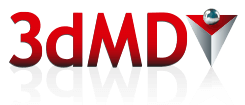June 2025. Welcome to 3dMD’s Spring 2025 Update. We are excited to announce several updates from the global 3dMD Community as well as the introduction of exciting new features to 3dMD’s technology lineup. Featuring…
• Seizing the Next Frontier: Dynamic-3D/4D to Quantify Subject Mobility
• Analyzing Facial Mobility in 4D – 3dMDtempus™ Software
• Integrating EMR within the 3dMDperform™ Workflow
• Training Artificial Intelligence with 3dMD Image Precision
• Presenting the Latest 3dMD Advancements to Industry
Seizing the Next Frontier: Dynamic-3D/4D to Quantify Subject Mobility. Gone are the days of using timeworn 3D technologies such as ‘static-3D’ surface scanners that output one scan at a time, and marker-based motion capture rigs that output ‘sparse-surface’ marker data. By combining the best features of each technology—namely the ability to capture dense-surface 3D images of the human anatomy in motion at up to 120 frames per second—3dMD’s advanced, dynamic-3D/4D technology offers innovative clinical/product and research teams both qualitative and quantitative 3D/4D output results. All this is achieved without the need for multiple imaging modalities in an efficient, end-to-end package – from subject capture – 3D dense-surface reconstruction – EMR integration, if health – 3D/4D tracking and analysis – and achieving output results.
Analyzing Facial Mobility in 4D – Downstream 3dMDtempus Software. Also gone are the days of needing to use a single 3D scan or a sparse marker data set to substantiate your anatomical findings. 3dMDtempus Software enables clinical/research/product teams to analyze a progressive sequence of ‘near-ground truth’ 3dMDimages to quantify a subject’s facial expressions, head position, movement, and speech. 3dMD’s advanced detection technique extracts key information to identify 68 facial features, informing the automatic detection of 86 head xyz landmarks (or 73 face xyz landmarks). A normalized ‘generic’ 3D cranial avatar template is registered to the reference ‘near-ground truth’ 3dMDimage serving as a foundation for precise head tracking and projection across a progressive sequence of 3dMDimages. The latest version of the 3dMDperform system control software enables a user to synchronize the capture data with audio, which enables teams to analyze facial movements associated with speech. If needed as a bridge back to a legacy static-3D paradigm, each ‘near-ground truth’ 3dMD image in a progressive sequence can be analyzed independently, and measurements can be extracted within seconds – e.g. smile apex, neutral, etc.
Integrating EMR within the 3dMDperform Workflow. Electronic Medical Records (EMRs) are a critical component of effective and efficient patient care. The increased transparency, portability, and accessibility of this information helps to facilitate more seamless communications through both patient engagement and education, as well as foster research collaboration. The increasing security requirements of the modern era likewise demand a well-managed data pipeline. As such, 3dMD is excited to roll out a comprehensive update to the 3dMDperform™ Software platform which facilitates not only an integration with an EMR system from a leading EHR software developer in the United States, but also introduces powerful dataset tagging, editing, search, and metadata tools to make 3dMD data management a breeze. This implementation will further improve adherence to HIPAA/GDPR requirements with options to safely and securely store PHI. Please let us know if you would like to learn more about 3dMD’s latest EMR integration.
Training Artificial Intelligence with 3dMD Image Precision. A fundamental principle in data analysis is “Good data in results… in good data out”. As AI technology continues to rapidly develop and be deployed across industries, adherence to this principle will likewise become increasingly critical. This is why researchers and product designers globally choose 3dMD—to ensure that the data going into their applications, designs, training algorithms, or otherwise, is of the highest quality to achieve the very best outcomes. For 25 years, 3dMD has solidified its reputation as the gold standard for human subject 3D/4D input applications that demand anatomical, ‘near-ground truth’ 3D-shape precision. Here is a sampling of some of the AI research that has been done by 3dMD customers using 3dMD data as the reference:
• September 2024. SHAPE: A visual computing pipeline for interactive landmarking of 3D photograms and patient reporting for assessing craniosynostosis. Carsten Görg, Connor Elkhill, Jasmine Chaij, Kristin Royalty, Phuong D Nguyen, Brooke French, Alejandro Cruz Guerrero, Antonio R Porras. Children’s Hospital Colorado, Aurora, CO, USA. Computers & Graphics, 104056, ISSN 0097-8493, https://doi.org/10.1016/j.cag.2024.104056.
• October 2024. Beyond the Surface: 3D and 4D Imaging for Craniofacial Assessment and Treatment. Rami R HALLAC, UT Southwestern Medical Center and Children’s Health, Dallas, USA, and Chris LANE, 3dMD. 3DBodyTech Conference, Lugano, Switzerland.
• March 2021. Automatic Assessment of 3-Dimensional Facial Soft Tissue Symmetry Before and After Orthognathic Surgery Using a Machine Learning Model: A Preliminary Experience. Lun-Jou Lo MD; Chao-Tung Yang PhD; Cheng-Ting Ho MD; Chun-Hao Liao BS; Hsiu-Hsia Lin, PhD. Annals of Plastic Surgery 86(3S):p S224-S228, DOI: 10.1097/SAP.0000000000002687.
Click to here see more published research from the 3dMD customer community.
Presenting the Latest 3dMD Advancements to Industry.
• 25 Years Experience of 4D Body Scanning…What Next?, 3dMD CEO Chris Lane, 2024 3DBODY.TECH Conference, October 2024 in Lugano, Switzerland.
• Authentic Real-World 3D/4D Human Data to Train AI, Wear Tech, and Image Health, 3dMD CEO Chris Lane, 2024 Augmented World Expo (AWE), June 2024 in Long Beach, CA, USA.
Contact. To learn more about 3dMD, contact us at info@3dMD.com.
